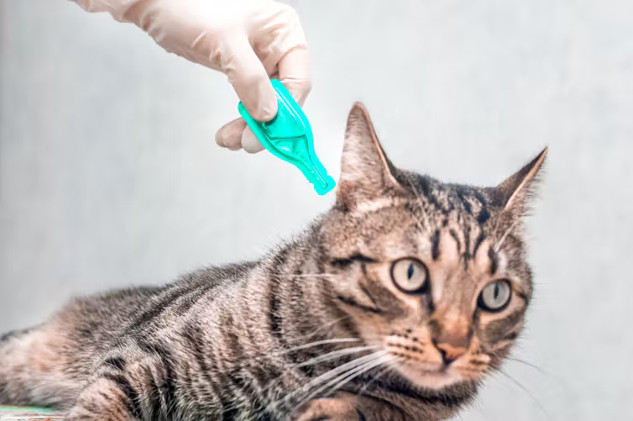
Anastasiya Tsiasemnikava/Shutterstock
Responsible owners of the UK’s 22 million cats and dogs may well have followed advice from many vets to treat pets with a monthly preventative “spot on” flea and tick treatment. However, these treatments are polluting our rivers and could pose a health risk to pet-loving families, according to noi cercetări.
Spot-on parasiticides are liquids applied to the back of the pet’s neck. They spread over the skin of the animal making it toxic to fleas (and sometimes ticks) for at least one month. They’re often sold as part of a pet healthcare plan, whereby pet owners make a monthly payment for a package of year-round treatments.
Around [86% of dogs and 91% of cats] are treated for fleas at least once a year, whether fleas are present or not. The cel mai comun active ingredients in these treatments are called imidacloprid (an insecticide linked to bee declines) and fipronil, another potent insecticide that can harm the nervous systems of animals and humans.
Recent surveys by the Environment Agency have detected these synthetic chemicals in river water samples from around the UK, with 99% of samples containing fipronil and 66% containing imidacloprid. Concentrations commonly exceeded what are deemed to be limite sigure by most experts.
How were these chemicals getting into rivers? Fipronil and imidacloprid were both banned for outdoor agricultural use by 2018, due to concerns over their persistence and toxicity to non-target insect life.
Aside from vet medicines, the only other use for fipronil and imidacloprid is in poison baits for ants and cockroaches, but there is no evidence that this is a significant source of the measured pollution. Dogs that have been treated with these chemicals and then swim in rivers seemed a plausible explanation.
Investigations by the research organisation UK Water Industry Research revealed that concentrations of both chemicals were much higher in effluent from wastewater treatment works, with very little removed through the treatment process, and in rivers downstream of wastewater treatment works. This strongly suggests that this pollution comes from a domestic source, such as washing down plugholes from homes.
To investigate this further, my colleagues and I studied what happens after these chemicals have been applied to a pet. We treated dogs with these chemicals and measured how much came off when dogs were bathed or stroked. We found that bathing dogs, washing bedding and owners washing hands were all significant sources of river pollution, sufficient to account for much of the pollution found in rivers. There were multiple likely additional pathways for these chemicals to end up going down the drain.
If you have a cat or dog you may well be wondering what you should do. In my opinion, preventative flea treatment is neither necessary nor desirable in most cases. Most dogs and cats don’t have fleas. Indoor cats are unlikely to catch fleas. Non-chemical methods such as flea traps, regular hot washing of the animal’s bedding to kill larval fleas and hoovering are effective. Regular flea combing helps detect and remove fleas.
Parasiticides usually only need to be used once an infestation has established – doing this would hugely reduce the use of these pesticides. There are also oral flea and tick treatments such as isoxazolines, which rapidly resolve flea infestations. These may be safer for the environment, but we don’t know for certain.
Aside from the obvious concern over river pollution, there are other issues to consider. Studiile indică a growing lack of effectiveness for older spot-on products, especially fipronil, suggesting that fleas are evolving resistance to these chemicals.
Proceed with precaution
To make sure newer classes of parasiticide such as isoxazolines remain as effective as possible, extensive preventative use cannot continue. Cercetarea anterioară has also raised concerns about possible health risks to pet owners and veterinary professionals from chronic exposure to pet parasiticides.
Our work supports these concerns, demonstrating that fipronil and imidacloprid readily transfer to bedding and owner’s hands, so they will quickly get smeared around the household. We found that the products last at least 28 days on dogs, so monthly applications will result in widespread and long-lasting contamination of households with these potent neurotoxins.
Very little research has been done on the effects of such exposure, but recent studies have found links between fipronil exposure and both diabet și hipertensiune arterială. Fipronil can transfer from mother to unborn baby via the placenta, and exposure to fipronil’s toxic breakdown product, fipronil sulfone, during pregnancy has been associated with reduced thyroid function in nou-născuți cât și mai jos Apgar înscrie, a score used to test the health of a newborn.
Pesticides, including parasiticides, can have a legitimate and important role in pest and disease control, but the current approach to parasite control in pets is neither responsible nor sustainable. To achieve a healthier and more environmentally-sound strategy, pesticides should only be used on pets with caution and for specific, targeted reasons.![]()
Dave Goulson, Professor of Biology (Evolution, Behaviour and Environment), Universitatea din Sussex
Acest articol este republicat de la Conversaţie sub licență Creative Commons. Citeste Articol original.
Cărți despre animale de companie din lista celor mai bine vândute de pe Amazon
„Ghidul începătorului pentru agilitatea câinilor”
de Laurie Leach
Această carte este un ghid cuprinzător pentru agilitatea câinilor, inclusiv tehnici de antrenament, echipament și reguli de competiție. Cartea include instrucțiuni pas cu pas pentru antrenament și competiție în agilitate, precum și sfaturi pentru selectarea câinelui și a echipamentului potrivit.
Click pentru mai multe informatii sau pentru a comanda
„Revoluția dresajului câinilor lui Zak George: Ghidul complet pentru creșterea animalului de companie perfect cu dragoste”
de Zak George și Dina Roth Port
În această carte, Zak George oferă un ghid cuprinzător pentru dresajul câinilor, inclusiv tehnici de întărire pozitivă și sfaturi pentru abordarea problemelor comune de comportament. Cartea include, de asemenea, informații despre selectarea câinelui potrivit și pregătirea pentru sosirea unui nou animal de companie.
Click pentru mai multe informatii sau pentru a comanda
„Geniul câinilor: cum sunt câinii mai inteligenți decât crezi”
de Brian Hare și Vanessa Woods
În această carte, autorii Brian Hare și Vanessa Woods explorează abilitățile cognitive ale câinilor și relația lor unică cu oamenii. Cartea include informații despre știința din spatele inteligenței câinilor, precum și sfaturi pentru îmbunătățirea legăturii dintre câini și stăpânii lor.
Click pentru mai multe informatii sau pentru a comanda
„Manualul cățelușului fericit: Ghidul tău definitiv pentru îngrijirea și formarea timpurie a cățelului”
de Pippa Mattinson
Această carte este un ghid cuprinzător pentru îngrijirea și formarea timpurie a cățelului, inclusiv sfaturi pentru selectarea cățelului potrivit, tehnici de dresaj și informații despre sănătate și nutriție. Cartea include și sfaturi pentru socializarea cățeilor și pregătirea pentru sosirea lor.
Click pentru mai multe informatii sau pentru a comanda

























